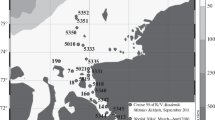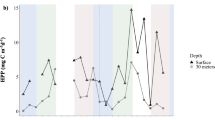Abstract
Zooplankton provide microhabitats for bacteria, but factors which influence zooplankton-associated bacterial abundance are not well known. Through a year-long field study, we measured the concentration of free-living bacteria and bacteria associated with the dominant mesozooplankters Acartia tonsa and Balanus sp. Free-living bacteria peaked in the summer, while zooplankton-associated bacteria peaked in summer and winter. No relationships were found between bacterial abundance per individual and zooplankter width, length, surface area or body volume. Multiple regression analyses indicated that free-living and Acartia-associated bacterial concentrations were explained by temperature, salinity, ammonium, chl a, and all term interactions. Balanus-associated bacterial concentration was explained by ammonium and phosphate. Ammonium significantly influenced all sampled bacterial communities. In laboratory experiments, copepods raised under high ammonium concentration had higher bacterial concentrations than those raised under low ammonium condition. Transplant experiments showed that high ammonium favored loosely attached bacteria, whereas low ammonium selected for firmly attached bacteria, suggesting greater exchange between free-living and zooplankton-associated bacterial communities in nutrient-rich systems. Additional sampling of other zooplankton taxa all showed high bacterial concentrations, supporting the notion that zooplankton function as microbial hotspots and may play an important, yet overlooked, role in marine biogeochemical cycles.




Similar content being viewed by others
References
Alldredge, A. L. & C. C. Gotschalk, 1990. The relative contribution of marine snow of different origins to biological processes in coastal waters. Continental Shelf Research 10: 41–58.
Amon, R. M. W. & R. Benner, 1998. Seasonal patterns of bacterial abundance and production in the Mississippi river plume and their importance for the fate of enhanced primary production. Microbial Ecology 35: 289–300.
Anderson, D. R., 2008. Model based inference in the life sciences: a primer on evidence. Springer, New York, NY.
Baird, D. & R. E. Ulanowicz, 1989. The seasonal dynamics of the Chesapeake Bay ecosystem. Ecological Monographs 59: 329–364.
Calbet, A., 2001. Mesozooplankton grazing impact on primary production: a global comparative analysis in marine ecosystems. Limnology and Oceanography 46: 1824–1830.
Carman, K. R., 1994. Stimulation of marine free-living and epibiotic bacterial activity by copepod excretions. FEMS Microbiology Ecology 14: 255–261.
Carman, K. R. & F. C. Dobbs, 1997. Epibiotic microorganisms on copepods and other marine crustaceans. Microscopy Research and Technique 37: 116–135.
Caro, A., A. Escalas, C. Bouvier, E. Grousset, N. Lautredou-Audouy, C. Roques, M. Charmantier & O. Gros, 2012. Epibiotic bacterial community of Sphaeroma serratum (Crustacea, Isopoda) in relation with molt status. Marine Ecology Progress Series 457: 11–27.
Chen, F., J. Lu, B. J. Binder, Y. Liu & R. E. Hodson, 2001. Application of digital image analysis and flow cytometry to enumerate marine viruses stained with SYBR gold. Applied and Environmental Microbiology 67: 539–545.
Condon, R. H., D. K. Steinberg & D. A. Bronk, 2010. Production of dissolved organic matter and inorganic nutrients by gelatinous zooplankton in the York River estuary, Chesapeake Bay. Journal of Plankton Research 32: 153–170.
Conover, R. J. & P. Mayzaud, 1975. Respiration and nitrogen excretion of neritic zooplankton in relation to potential food supply. 10th European Symposium on Marine Biology, Ostend, Belgium 2: 151–163.
Cotner, J. B., T. H. Johengen & B. A. Biddanda, 2000. Intense winter heterotrophic production stimulated by benthic resuspension. Limnology and Oceanography 45: 1672–1676.
de Angelis, M. A. & C. Lee, 1994. Methane production during zooplankton grazing on marine phytoplankton. Limnology and Oceanography 36: 1298–1308.
Durbin, E. G., A. G. Durbin & R. G. Campbell, 1992. Body size and egg production in the marine copepod Acartia hudsonica during a winter-spring diatom bloom in Narragansett Bay. Limnology and Oceanography 37: 342–360.
Elliott, D. T. & K. W. Tang, 2011. Spatial and temporal distributions of live and dead copepods in the lower Chesapeake Bay (Virginia, USA). Estuaries and Coasts 34: 1039–1048.
Felip, M., M. L. Pace & J. J. Cole, 1996. Regulation of planktonic bacterial growth rates: the effects of temperature and resources. Microbial Ecology 31: 15–28.
Fukuda, R., H. Ogawa, T. Nagata & I. Koike, 1998. Direct determination of carbon and nitrogen contents of natural bacterial assemblages in marine environments. Applied and Environmental Microbiology 64: 3352–3358.
Gaston, K. J. & J. H. Lawton, 1990. Effects of scale and habitat on the relationship between regional distribution and local abundance. Oikos 58: 329–335.
Goosen, N., P. van Rijswijk, J. Kromkamp & J. Peene, 1997. Regulation of annual variation in heterotrophic bacterial production in the Schelde estuary (SW Netherlands). Aquatic Microbial Ecology 12: 223–232.
Grossart, H. P. & K. W. Tang, 2010. Communicative & Integrative Biology 3: 1–4. www.aquaticmicrobial.net.
Grossart, H. P., C. Dziallas & K. W. Tang, 2009. Bacterial diversity associated with freshwater zooplankton. Environmental Microbiology Reports 1: 50–55.
Heidelberg, J. F., K. B. Heidelberg & R. R. Colwell, 2002. Bacteria of the γ-subclass Proteobacteria associated with zooplankton in Chesapeake Bay. Applied and Environmental Microbiology 68: 5498–5507.
Hoch, M. P. & D. L. Kirchman, 1993. Seasonal and inter-annual variability in bacterial production and biomass in a temperate estuary. Marine Ecology Progress Series 98: 283–295.
Kemp, W., W. Boynton, J. Adolf, D. Boesch, W. Boicourt, G. Brush, J. Cornwell, T. Fisher, P. Glibert, J. Hagy, L. Harding, E. Houde, D. Kimmel, W. Miller, R. Newell, M. Roman, E. Smith & J. Stevenson, 2005. Eutrophication of Chesapeake Bay: historical trends and ecological interactions. Marine Ecology Progress Series 303: 1–29.
Kiørboe, T., F. Møhlenberg & K. Hamburger, 1985. Bioenergetics of the planktonic copepod Acartia tonsa: relation between feeding, egg production and respiration, and composition of specific dynamic action. Marine Ecology Progress Series 26: 85–97.
Kiørboe, T., E. Saiz & M. Viitasalo, 1996. Prey switching behaviour in the planktonic copepod Acartia tonsa. Marine Ecology Progress Series 143: 65–75.
Kirchman, D. L., 1994. The uptake of inorganic nutrients by heterotrophic bacteria. Microbial Ecology 28: 255–271.
Kleppel, G. S., 1993. On the diets of calanoid copepods. Marine Ecology Progress Series 99: 183–195.
Koroleff, F., 1983. Determination of nutrients. In Grasshoff, K., M. Ehrhardt & K. Kremling (eds), Methods of Seawater Analysis. Verlag Chemie, New York: 125–187.
Marty, D. G., 1993. Methanogenic bacteria in seawater. Limnology and Oceanography LIOCAH 38: 452–456.
Møller, E. F., 2005. Sloppy feeding in marine copepods: prey-size-dependent production of dissolved organic carbon. Journal of Plankton Research 27: 27–35.
Møller, E. F., L. Riemann & M. Søndergaard, 2007. Bacteria associated with copepods: abundance, activity and community composition. Aquatic Microbial Ecology 47: 99–106.
Paerl, H., 1980. Attachment of microorganisms to living and detrital surfaces in freshwater systems. In Bitton, G. & K. Marshall (eds), Adsorption of Microorganisms to Surfaces. Wiley, New York, NY: 375–402.
Parsons, T. R., Y. Maita & C. M. Lalli, 1984. A manual of chemical and biological methods for seawater analysis. Pergamon Press, New York.
Peierls, B. & H. Paerl, 2010. Temperature, organic matter, and the control of bacterioplankton in the Neuse River and Pamlico Sound estuarine system. Aquatic Microbial Ecology 60: 139–149.
Pomeroy, L. & W. Wiebe, 2001. Temperature and substrates as interactive limiting factors for marine heterotrophic bacteria. Aquatic Microbial Ecology 23: 187–204.
Pomeroy, L., W. Wiebe, D. Deibel, R. Thompson, G. Rowe & J. D. Pakulski, 1991. Bacterial responses to temperature and substrate concentration during the Newfoundland spring bloom. Marine Ecology Progress Series 75: 143–159.
Porter, K. G. & Y. S. Feig, 1980. The use of DAPI for identifying and counting aquatic microflora. Limnology and Oceanography 25: 943–948.
Proctor, L., 1997. Nitrogen-fixing, photosynthetic, anaerobic bacteria associated with pelagic copepods. Aquatic Microbial Ecology 12: 105–113.
Qiu, J., L. Gosselin & P. Qian, 1997. Effects of short-term variation in food availability on larval development in the barnacle Balanus amphitrite amphitrite. Marine Ecology Progress Series 161: 83–91.
Raymond, P. A. & J. E. Bauer, 2001. DOC cycling in a temperate estuary: a mass balance approach using natural 14C and 13C isotopes. Limnology and Oceanography 46: 655–667.
Revilla, M., A. Iriarte, I. Madariaga & E. Orive, 2000. Bacterial and phytoplankton dynamics along a trophic gradient in a shallow temperate estuary. Estuarine, Coastal and Shelf Science 50: 297–313.
Schultz, G., E. White & H. Ducklow, 2003. Bacterioplankton dynamics in the York River estuary: primary influence of temperature and freshwater inputs. Aquatic Microbial Ecology 30: 135–148.
Shiah, F. & H. W. Ducklow, 1994. Temperature regulation of heterotrophic bacterioplankton abundance, production, and specific growth rate in Chesapeake Bay. Limnology and Oceanography 39: 1243–1258.
Simon, M., H. Grossart, B. Schweitzer & H. Ploug, 2002. Microbial ecology of organic aggregates in aquatic ecosystems. Aquatic Microbial Ecology 28: 175–211.
Steinberg, D. K. & R. H. Condon, 2009. Zooplankton of the York River. Journal of Coastal Research 57: 66–79.
Tang, K. W., 2005. Copepods as microbial hotspots in the ocean: effects of host feeding activities on attached bacteria. Aquatic Microbial Ecology 38: 31–40.
Tang, K. W., V. Turk & H. P. Grossart, 2010. Crustacean zooplankton as microhabitats for bacteria. Aquatic Microbial Ecology 61: 261–277.
Tang, K. W., R. N. Glud, A. Glud, S. Rysgaard & T. G. Nielsen, 2011. Copepod guts as biogeochemical hotspots in the sea: evidence from microelectrode profiling of Calanus spp. Limnology and Oceanography 56: 666–672.
Titelman, J., L. Riemann, K. Holmfeldt & T. Nilsen, 2008. Copepod feeding stimulates bacterioplankton activities in a low phosphorus system. Aquatic Biology 2: 131–141.
Zettler, E. R., T. J. Mincer & L. A. Amaral-Zettler, 2013. Life in the “Plastisphere”: microbial communities on plastic marine debris. Environmental Science & Technology 47: 7137–7146.
Acknowledgments
The authors thank Q. Roberts and S. Baer for assistance in nutrient analysis and F. C. Dobbs for helpful suggestions and review of the manuscript. The manuscript was improved through helpful suggestions from two anonymous reviewers. This research was funded by the National Science Foundation OCE-0814558. SLB received additional support from the National Science Foundation GK-12 (Division of Graduate Education 0840804). This is contribution number 3320 of the Virginia Institute of Marine Science.
Author information
Authors and Affiliations
Corresponding author
Additional information
Handling editor: Stefano Amalfitano
Rights and permissions
About this article
Cite this article
Bickel, S.L., Tang, K.W. Zooplankton-associated and free-living bacteria in the York River, Chesapeake Bay: comparison of seasonal variations and controlling factors. Hydrobiologia 722, 305–318 (2014). https://doi.org/10.1007/s10750-013-1725-0
Received:
Revised:
Accepted:
Published:
Issue Date:
DOI: https://doi.org/10.1007/s10750-013-1725-0




